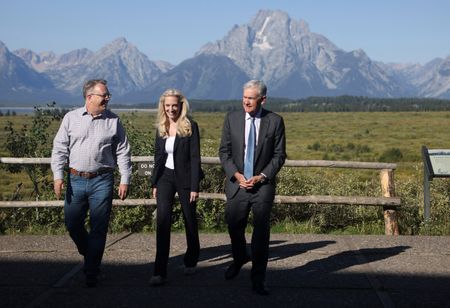By Michael S. Derby
NEW YORK (Reuters) -New York Federal Reserve President John Williams on Monday said the U.S. central bank needs to press forward with rate rises but did not say how fast and how far it will need to boost short-term borrowing costs, even as he reckons a rate cut is possible in 2024 as inflation pressures likely ease.
“I do think we’re going to need to keep restrictive policy in place for some time; I would expect that to continue through at least next year,” Williams said at a virtual event held by the Economic Club of New York, noting that borrowing costs need to rise to bring down overly high levels of inflation. “I do see a point probably in 2024 that we’ll start bringing down nominal interest rates because inflation is coming down.”
The Fed has boosted the cost of short-term borrowing aggressively this year in its battle to curb inflation. By the Fed’s preferred measure, inflation has been running at more than three times the central bank’s 2% target this entire year.
While Williams pointed to some signs of progress in bringing down inflation, he said interest rates needed to rise further.
“How high those rates need to be will depend on how the economy and inflation evolve,” Williams said.
Williams is vice chair of the rate-setting Federal Open Market Committee, which holds its next policy meeting on Dec. 13-14. The Fed has pushed through oversized 75-basis-point rate increases at its last four policy meetings, bringing the target rate to the current 3.75%-4.00% range.
Fed officials signaled both at the central bank’s November meeting and in comments since then that they may find the space to slow the pace of the increases in borrowing costs as they close in on a resting point for their rate-rise campaign. That has opened the door to the prospect the Fed could raise its target rate by 50 basis points at the next gathering.
Williams did not offer any guidance on his preferred size for the rate hike at next month’s meeting, or for the ultimate destination of the federal funds rate, which most policymakers in September thought would be between 4.5% and 5.0%.
But he notably did not push back on the idea that the Fed could move at a slower pace next month. The federal funds rate futures market on Monday put a 68% probability on the prospect of a half-percentage-point rise at the Dec. 13-14 meeting.
JOB LOSSES WARNING
With economic growth expected to be in modestly positive territory this year and next, Williams said the U.S. unemployment rate will likely rise to between 4.5% and 5.0% by the end of next year, from the current 3.7%.
Still, he said a recession is not part of his baseline forecast, though risks are to the downside. Williams noted to reporters after his formal remarks that the risks to the economy lie to the downside, and said that based on his outlook, activity is particularly vulnerable to shocks that could send the nation into a recession.
Meanwhile, slower global growth and improving supply chains should help lower inflation. Compared to the 6.2% rise in September in the Fed’s preferred inflation gauge, the personal consumption expenditures price index, Williams said inflation should ease to between 5.0% and 5.5% by the close of 2022 and to 3.0% to 3.5% next year.
Williams also said the bond market has been holding up fairly well in the face of the Fed’s actions.
(Reporting by Michael S. Derby and Ann Saphir; Editing by Paul Simao)

